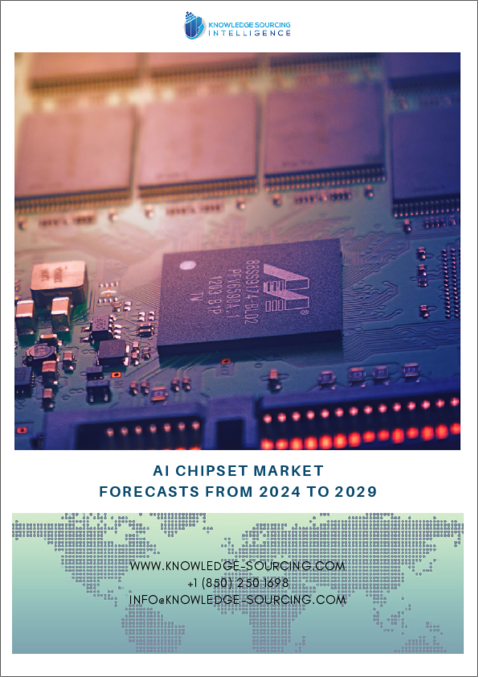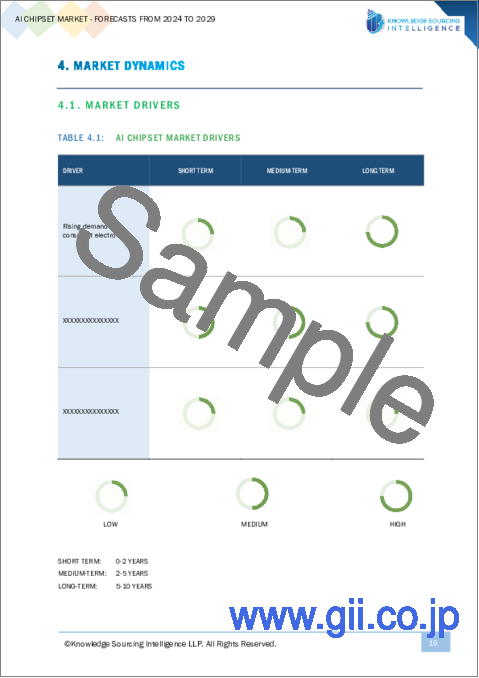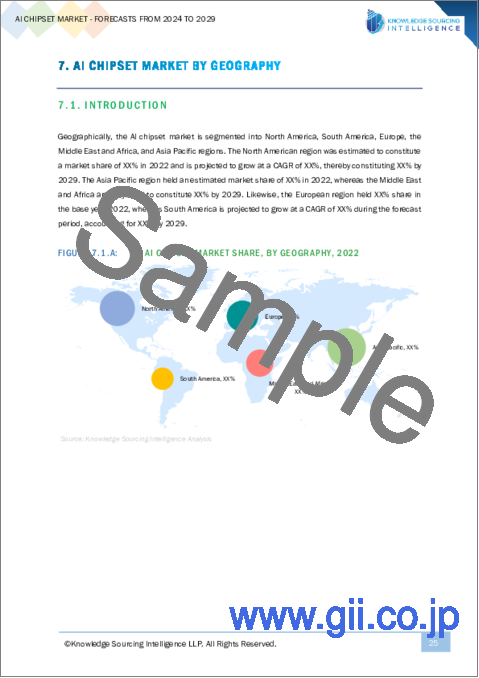|
|
市場調査レポート
商品コード
1456873
AIチップセット市場-2024年から2029年までの予測AI Chipsets Market - Forecasts from 2024 to 2029 |
||||||
|
● お客様のご希望に応じて、既存データの加工や未掲載情報(例:国別セグメント)の追加などの対応が可能です。 詳細はお問い合わせください。 |
|||||||
| AIチップセット市場-2024年から2029年までの予測 |
|
出版日: 2024年02月09日
発行: Knowledge Sourcing Intelligence
ページ情報: 英文 118 Pages
納期: 即日から翌営業日
|
- 全表示
- 概要
- 目次
AIチップセット市場はCAGR 25.87%で成長し、2022年の318億米ドルから2029年には1,591億6,700万米ドルに達すると予測されています。
Alは多くのセグメントを変革する技術へと進化しています。Alチップセットは、高速製造、低レイテンシ、コンピューティング機能を提供するよう特別に設計されており、Alアプリケーションをより迅速かつ効果的に実行できます。企業はAlを使用して、業務の自動化、洞察に満ちたデータ洞察力の獲得、意思決定の向上、顧客体験の改善、イノベーションの促進を図っています。Alの利用が広まるにつれて、Alのワークロードを効果的に処理できる専用ハードウェアの需要が高まっており、Alチップセット産業の拡大に拍車をかけています。
市場の促進要因
- AIシステム構築への注目の高まりが、世界の産業成長を促進しています。
人間を意識したAIシステムの構築に注目が集まっている結果、AIチップセット市場は拡大しています。しかし、規範や規制の不在、熟練労働者の供給がAIチップセット市場の拡大を制限しています。人工知能が技術セグメントで進歩し続けるにつれて、相当数のASICに対する需要が高まる可能性が高いです。AmazonやGoogleのような企業は、すでにサーバー・シリコン・プロジェクトの強化に取り組んでいます。各社は人工知能のような最先端技術を採用した新しいAIチップを開発しています。例えば、2021年6月に学術誌「ネイチャー」に掲載された論文によると、Googleは次世代AIプロセッサーの開発を支援するためにAIと機械学習を活用しています。同企業は、AIは人間が数ヶ月かかる作業を6時間以内に終わらせることができると主張しています。
- 家電需要の高まりが市場に新たな成長展望をもたらす
タブレットやスマートフォンを含む様々な電子ガジェットのハイエンド仕様は、AIチップセット業界で非常に使用されており、家電製品におけるAIチップセットの需要を高めています。高まる需要に応えるため、数多くのメーカーが常に最先端のAIチップセットをリリースしています。例えば、台湾のチップメーカーであるMediaTekは、2022年5月にモノの人工知能(AIoT)デバイス向けのGenioアーキテクチャとGenio 1200チップを発表しました。メディアテックによると、Genio 1200チップをベースにしたプレミアムAIoTソリューションは、2022年後半に市販される予定です。
さらに、量子コンピューティング技術を利用した分析計算や複雑な問題解決の利用が増加していることも、AIチップセット市場を拡大しています。例えば、グーグルLLCの量子コンピュータSycamoreは、最速のコンピュータを使って約200秒でタスクを完了することができます。人工知能、機械学習、マシンビジョン、ビッグデータ、拡大現実(AR)などの技術が量子コンピュータを可能にしています。量子コンピュータに対する理解が深まるにつれてAIチップセットの需要は増加し、このセグメントの成長を加速させると考えられます。
- データ量の増加が市場成長を後押し。
データ量の大幅な増加は、ソーシャルメディアやeコマースの利用拡大によってもたらされています。データ量の急速な増加に伴い、高速プロセッサーのニーズが高まっており、これがAIチップセット市場の拡大に好影響を与えています。このチップセットは、機械学習が活性化することによる高速処理のニーズに対応します。コンピューター・ビジョンや機械学習ツールに対する一般市民の嗜好が、技術系企業の高速プロセッサー開発への意欲を高めています。例えば、AMDは2023年に、AI専用エンジンを搭載した初のx86 PC用CPUを含む、新しいモバイルCPUとGPUを発表しました。2023年のCESでAMDは、卓越したゲーム性能を持つ新しい3D積層デスクトップCPU、データセンター向けAPU、AI推論アクセラレーターも発表しました。こうした開発により、スマートフォンの普及も進んでいます。例えば、GSMAによると、スマートフォンの普及率は2021年の75%から2025年には84%増加すると予想されています。
- 好意的な投資と他の用途での利用拡大が市場の成長を後押ししています。
AI用途の複雑化に伴い、高性能なAIチップセットへの需要が高まっています。例えば、自動運転車には、大量のデータをリアルタイムで処理できるAIチップセットが必要です。また、医療画像解析アプリケーションでは、複雑なアルゴリズムを扱えるAIチップセットが必要となります。さらに、技術企業は新しいAIチップセットを開発するために、研究開発に多額の投資を行っています。これは、AIチップセットの性能と効率の向上に役立っており、AIチップセット業界の成長をさらに促進しています。例えば、NVIDIAは2022年に1億米ドルをGPU(グラフィック・プロセッシング・ユニット)技術の開発に投資しており、このGPUは様々なAI用途で使用されています。
北米は大きな成長が見込まれる
北米地域は、主要な地域経済国であるアメリカにおける様々なセグメントでの産業用ロボットの設置の活況に後押しされ、かなりの市場シェアを占めると予想されます。2019~2021年にかけて、自動化と高度製造技術への大幅なシフトが反映されます。自動車部門では、ロボットの設置台数は2019年の9,800台から2021年には1万3,000台に増加し、32%の著しい伸びを示しました。また、電気・電子部門も堅調な伸びを示し、同期間にロボットの設置台数は20%増加しました。さらに、国際ロボット連盟によると、2022年には米国が南北アメリカ市場のロボット設置台数全体の71%を占め、メキシコも設置台数で13%の伸びを示しました。このような自動化の成長は、北米地域の拡大するAIチップセット市場と一致しており、これらのロボットは多くの場合、効率と精度の向上のためにAI駆動技術に依存しています。この相乗効果は、産業オートメーションとイノベーションを推進する上でAIチップセットが極めて重要な役割を担っていることを強調しています。
目次
第1章 イントロダクション
- 市場概要
- 市場の定義
- 調査範囲
- 市場セグメンテーション
- 通貨
- 前提条件
- 基準年と予測年のタイムライン
- 関係者にとっての主要メリット
第2章 調査手法
- 調査デザイン
- 調査プロセス
第3章 エグゼクティブサマリー
- 主要調査結果
- アナリストビュー
第4章 市場力学
- 市場促進要因
- 市場抑制要因
- ポーターのファイブフォース分析
- 業界バリューチェーン分析
- アナリストビュー
第5章 AIチップセット市場:コンポーネント別
- イントロダクション
- GPU(グラフィックスプロセッシングユニット)
- FPGA(フィールドプログラマブルゲートアレイ)
- ASIC(特定用途向け集積回路)
- その他
第6章 AIチップセット市場:エンドユーザー別
- イントロダクション
- 自動車
- 家電
- 産業用
- 医療
- その他
第7章 AIチップセット市場:地域別
- イントロダクション
- 北米
- 南米
- 欧州
- 中東・アフリカ
- アジア太平洋
第8章 競合環境と分析
- 主要企業と戦略分析
- 市場シェア分析
- 合併、買収、合意とコラボレーション
- 競合ダッシュボード
第9章 企業プロファイル
- AMD Inc
- Graphcore Ltd
- Huawei Technologies Co Ltd
- IBM Corporation
- Intel Corporation
- NVIDIA Corporation
- Micron Technology Inc
- Samsung Semiconductor
The AI chipsets market is projected to grow at a CAGR of 25.87% to reach US$159.167 billion in 2029 from US$31.800 billion in 2022.
Al has evolved into a technology that is transforming numerous sectors. Al (chipsets) is specifically designed to offer high-speed manufacturing, low latency, and computing capabilities, enabling Al applications to run more quickly and effectively. Businesses are using Al to automate operations, acquire insightful data insights, increase decision-making, improve customer experiences, and spur innovation. The demand for specialized hardware that can effectively handle Al workloads is increasing as Al use spreads, fueling the expansion of the Al (chipsets) industry.
Market Drivers
- Increasing focus on creating AI systems has propelled the industrial growth globally.
The AI Chipsets market is expanding as a result of the increased attention being paid to creating AI systems that are aware of humans. The absence of norms and regulations as well as a skilled labor supply are, however, limiting the AI Chipsets market expansion. As artificial intelligence continues to advance in the field of technology, there will likely be an increased demand for a significant number of ASICs. Companies like Amazon and Google are already working to strengthen their server silicon projects. Companies are developing new AI chips employing cutting-edge technology like artificial intelligence. For instance, Google is utilizing AI and machine learning to assist in creating its next generation of AI processors, according to a paper published in the journal Nature in June 2021. The business claims that AI can finish tasks that take humans months to complete in less than six hours.
- Rising demand for consumer electronics has provided new growth prospects for the market
High-end specifications for a variety of electronic gadgets, including tablets and smartphones, are highly used in the AI Chipsets industry which is increasing the demand for AI chipsets in consumer electronics. To meet the growing demand, numerous manufacturers are constantly releasing cutting-edge AI chipsets. For instance, MediaTek, a Taiwanese chip manufacturer, unveiled the Genio architecture and Genio 1200 chip for artificial intelligence of things (AIoT) devices in May 2022. According to MediaTek, premium AIoT solutions based on the Genio 1200 chip will be commercially available in the second part of 2022.
Further, the rising usage of analytical computations and complex problem-solving using quantum computing technology is also increasing the AI Chipsets market. The Sycamore quantum computer from Google LLC, for example, can complete a task using the fastest computer in around 200 seconds. Artificial intelligence, machine learning, machine vision, big data, augmented reality (AR), and other technologies enable quantum computers. The demand for AI chipsets will increase as our understanding of quantum computing deepens, accelerating the growth of the sector.
- Growth in data volume has bolstered the market growth.
A significant increase in data volume is brought on by the expanding use of social media and e-commerce. The need for high-speed processors has increased as a result of the data volume's quick growth, which is favorably affecting the AI Chipsets market expansion. The chipset takes care of the need for quicker processing caused by machine learning that is activated. The public's preference for computer vision and machine learning tools motivates tech companies to make developments in the development of high-speed processors. For instance, AMD released new mobile CPUs and GPUs in 2023, including the first x86 PC CPU with a dedicated AI engine. At CES 2023, AMD also unveiled a new 3D-stacked desktop CPU with outstanding gaming performance, a data center APU, and an AI inference accelerator. These developments have also increased smartphone adoption. For instance, as per GSMA, the adoption of smartphones is expected to increase by 84% in 2025 from 75% in 2021.
- Favorable investments and growing usage in other applications has augmented the market growth.
The demand for high-performance AI chipsets is growing as AI applications become more complex. For example, self-driving cars require AI chipsets that can process large amounts of data in real time. And medical image analysis applications require AI chipsets that can handle complex algorithms. Moreover, technology companies are investing heavily in R&D to develop new AI chipsets. This is helping to improve the performance and efficiency of AI chipsets, which is further driving AI Chipsets industry growth. For example, NVIDIA invested US$100 million in 2022 in the development of its GPU (graphics processing unit) technology, which is used in a variety of AI applications.
North American is expected to show a significant growth
The North American region is anticipated to hold a considerable market share fueled by the booming the booming installation of industrial robots in various sectors in the major regional economies namley USA. From 2019 to 2021 reflects a substantial shift towards automation and advanced manufacturing technologies. In the automotive sector, the number of robots installed increased from 9.8 thousand in 2019 to 13 thousand in 2021, showcasing a remarkable 32% growth. The electrical/electronics sector also witnessed a steady rise, with a 20% increase in robot installations over the same period. Furthermore, according to the International Federation of Robotics, in 2022, United States accounted for 71% of the total robotics installation in the Americas market, and Mexico also witnessed 13% growth in installation. Such growth in automation aligns with the expanding AI Chipsets market in the North American region as these robots often rely on AI-driven technologies for improved efficiency and precision. This synergy underscores the pivotal role of AI chipsets in driving industrial automation and innovation.
Key Developments
- In December 2023: Intel at its "AI Everywhere" event launched its new portfolio of AI products to enable consumers access to AI products across cloud, network, PC, and data centers. The portfolio included AI chipset "Gaudi 3".
Segmentation:
By Component
- GPU (Graphic Processing Unit)
- FGPA (Field-Programmable Gate Array)
- ASIC (Application-Specific Integrated Circuit)
- Others
By End-User
- Automotives
- Consumer Electronics
- Industrial
- Healthcare
- Others
By Geography
- North America
- United States
- Canada
- Mexico
- South America
- Brazil
- Argentina
- Others
- Europe
- United Kingdom
- Germany
- France
- Italy
- Spain
- Others
- Middle East and Africa
- Saudi Arabia
- UAE
- Others
- Asia Pacific
- China
- Japan
- India
- South Korea
- Taiwan
- Australia
- Others
TABLE OF CONTENTS
1. INTRODUCTION
- 1.1. Market Overview
- 1.2. Market Definition
- 1.3. Scope of the Study
- 1.4. Market Segmentation
- 1.5. Currency
- 1.6. Assumptions
- 1.7. Base, and Forecast Years Timeline
- 1.8. Key Benefits for the stakeholder
2. RESEARCH METHODOLOGY
- 2.1. Research Design
- 2.2. Research Processes
3. EXECUTIVE SUMMARY
- 3.1. Key Findings
- 3.2. Analyst View
4. MARKET DYNAMICS
- 4.1. Market Drivers
- 4.2. Market Restraints
- 4.3. Porter's Five Forces Analysis
- 4.3.1. Bargaining Power of Suppliers
- 4.3.2. Bargaining Power of Buyers
- 4.3.3. Threat of New Entrants
- 4.3.4. Threat of Substitutes
- 4.3.5. Competitive Rivalry in the Industry
- 4.4. Industry Value Chain Analysis
- 4.5. Analyst View
5. AI CHIPSETS MARKET BY COMPONENT
- 5.1. Introduction
- 5.2. GPU (Graphic Processing Unit)
- 5.2.1. Market Trends and Opportunities
- 5.2.2. Growth Prospects
- 5.2.3. Geographic Lucrativeness Insights
- 5.3. FGPA (Field-Programmable Gate Array)
- 5.3.1. Market Trends and Opportunities
- 5.3.2. Growth Prospects
- 5.3.3. Geographic Lucrativeness Insights
- 5.4. ASIC (Application-Specific Integrated Circuit)
- 5.4.1. Market Trends and Opportunities
- 5.4.2. Growth Prospects
- 5.4.3. Geographic Lucrativeness Insights
- 5.5. Others
- 5.5.1. Market Trends and Opportunities
- 5.5.2. Growth Prospects
- 5.5.3. Geographic Lucrativeness Insights
6. AI CHIPSETS MARKET BY END-USER
- 6.1. Introduction
- 6.2. Automotives
- 6.2.1. Market Trends and Opportunities
- 6.2.2. Growth Prospects
- 6.2.3. Geographic Lucrativeness Insights
- 6.3. Consumer Electronics
- 6.3.1. Market Trends and Opportunities
- 6.3.2. Growth Prospects
- 6.3.3. Geographic Lucrativeness Insights
- 6.4. Industrial
- 6.4.1. Market Trends and Opportunities
- 6.4.2. Growth Prospects
- 6.4.3. Geographic Lucrativeness Insights
- 6.5. Healthcare
- 6.5.1. Market Trends and Opportunities
- 6.5.2. Growth Prospects
- 6.5.3. Geographic Lucrativeness Insights
- 6.6. Others
- 6.6.1. Market Trends and Opportunities
- 6.6.2. Growth Prospects
- 6.6.3. Geographic Lucrativeness Insights
7. AI CHIPSETS MARKET BY GEOGRAPHY
- 7.1. Introduction
- 7.2. North America
- 7.2.1. By Component
- 7.2.2. By End-User
- 7.2.3. By Country
- 7.2.3.1. USA
- 7.2.3.1.1. Market Trends and Opportunities
- 7.2.3.1.2. Growth Prospects
- 7.2.3.2. Canada
- 7.2.3.2.1. Market Trends and Opportunities
- 7.2.3.2.2. Growth Prospects
- 7.2.3.3. Mexico
- 7.2.3.3.1. Market Trends and Opportunities
- 7.2.3.3.2. Growth Prospects
- 7.2.3.1. USA
- 7.3. South America
- 7.3.1. By Component
- 7.3.2. By End-User
- 7.3.3. By Country
- 7.3.3.1. Brazil
- 7.3.3.1.1. Market Trends and Opportunities
- 7.3.3.1.2. Growth Prospects
- 7.3.3.2. Argentina
- 7.3.3.2.1. Market Trends and Opportunities
- 7.3.3.2.2. Growth Prospects
- 7.3.3.3. Others
- 7.3.3.3.1. Market Trends and Opportunities
- 7.3.3.3.2. Growth Prospects
- 7.3.3.1. Brazil
- 7.4. Europe
- 7.4.1. By Component
- 7.4.2. By End-User
- 7.4.3. By Country
- 7.4.3.1. United Kingdom
- 7.4.3.1.1. Market Trends and Opportunities
- 7.4.3.1.2. Growth Prospects
- 7.4.3.2. Germany
- 7.4.3.2.1. Market Trends and Opportunities
- 7.4.3.2.2. Growth Prospects
- 7.4.3.3. France
- 7.4.3.3.1. Market Trends and Opportunities
- 7.4.3.3.2. Growth Prospects
- 7.4.3.4. Italy
- 7.4.3.4.1. Market Trends and Opportunities
- 7.4.3.4.2. Growth Prospects
- 7.4.3.5. Spain
- 7.4.3.5.1. Market Trends and Opportunities
- 7.4.3.5.2. Growth Prospects
- 7.4.3.6. Others
- 7.4.3.6.1. Market Trends and Opportunities
- 7.4.3.6.2. Growth Prospects
- 7.4.3.1. United Kingdom
- 7.5. Middle East and Africa
- 7.5.1. By Component
- 7.5.2. By End-User
- 7.5.3. By Country
- 7.5.3.1. Saudi Arabia
- 7.5.3.1.1. Market Trends and Opportunities
- 7.5.3.1.2. Growth Prospects
- 7.5.3.2. UAE
- 7.5.3.2.1. Market Trends and Opportunities
- 7.5.3.2.2. Growth Prospects
- 7.5.3.3. Others
- 7.5.3.3.1. Market Trends and Opportunities
- 7.5.3.3.2. Growth Prospects
- 7.5.3.1. Saudi Arabia
- 7.6. Asia Pacific
- 7.6.1. By Component
- 7.6.2. By End-User
- 7.6.3. By Country
- 7.6.3.1. China
- 7.6.3.1.1. Market Trends and Opportunities
- 7.6.3.1.2. Growth Prospects
- 7.6.3.2. Japan
- 7.6.3.2.1. Market Trends and Opportunities
- 7.6.3.2.2. Growth Prospects
- 7.6.3.3. India
- 7.6.3.3.1. Market Trends and Opportunities
- 7.6.3.3.2. Growth Prospects
- 7.6.3.4. South Korea
- 7.6.3.4.1. Market Trends and Opportunities
- 7.6.3.4.2. Growth Prospects
- 7.6.3.5. Taiwan
- 7.6.3.5.1. Market Trends and Opportunities
- 7.6.3.5.2. Growth Prospects
- 7.6.3.6. Australia
- 7.6.3.6.1. Market Trends and Opportunities
- 7.6.3.6.2. Growth Prospects
- 7.6.3.7. Others
- 7.6.3.7.1. Market Trends and Opportunities
- 7.6.3.7.2. Growth Prospects
- 7.6.3.1. China
8. COMPETITIVE ENVIRONMENT AND ANALYSIS
- 8.1. Major Players and Strategy Analysis
- 8.2. Market Share Analysis
- 8.3. Mergers, Acquisitions, Agreements, and Collaborations
- 8.4. Competitive Dashboard
9. COMPANY PROFILES
- 9.1. AMD Inc
- 9.2. Graphcore Ltd
- 9.3. Huawei Technologies Co Ltd
- 9.4. IBM Corporation
- 9.5. Intel Corporation
- 9.6. NVIDIA Corporation
- 9.7. Micron Technology Inc
- 9.8. Samsung Semiconductor




